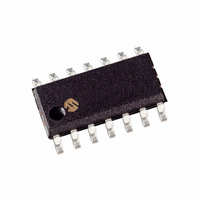PIC16F506-I/SL Microchip Technology, PIC16F506-I/SL Datasheet - Page 39

PIC16F506-I/SL
Manufacturer Part Number
PIC16F506-I/SL
Description
IC PIC MCU FLASH 1KX14 14SOIC
Manufacturer
Microchip Technology
Series
PIC® 16Fr
Datasheets
1.PIC12F510-ISN.pdf
(124 pages)
2.PIC16F506-ISL.pdf
(12 pages)
3.PIC16F506-ISL.pdf
(8 pages)
4.PIC16F506-ISL.pdf
(22 pages)
5.PIC16F506-IP.pdf
(114 pages)
Specifications of PIC16F506-I/SL
Program Memory Type
FLASH
Program Memory Size
1.5KB (1K x 12)
Package / Case
14-SOIC (3.9mm Width), 14-SOL
Core Processor
PIC
Core Size
8-Bit
Speed
20MHz
Peripherals
POR, WDT
Number Of I /o
11
Ram Size
67 x 8
Voltage - Supply (vcc/vdd)
2 V ~ 5.5 V
Data Converters
A/D 4x8b
Oscillator Type
Internal
Operating Temperature
-40°C ~ 85°C
Processor Series
PIC16F
Core
PIC
Data Bus Width
8 bit
Data Ram Size
67 B
Maximum Clock Frequency
20 MHz
Number Of Programmable I/os
12
Number Of Timers
1
Maximum Operating Temperature
+ 85 C
Mounting Style
SMD/SMT
3rd Party Development Tools
52715-96, 52716-328, 52717-734
Development Tools By Supplier
PG164130, DV164035, DV244005, DV164005, PG164120, ICE2000
Minimum Operating Temperature
- 40 C
On-chip Adc
3-ch x 8-bit
Lead Free Status / RoHS Status
Lead free / RoHS Compliant
Eeprom Size
-
Connectivity
-
Lead Free Status / Rohs Status
Lead free / RoHS Compliant
Available stocks
Company
Part Number
Manufacturer
Quantity
Price
Company:
Part Number:
PIC16F506-I/SL
Manufacturer:
MICROCHIP
Quantity:
16 700
Company:
Part Number:
PIC16F506-I/SL
Manufacturer:
Microchip Technology
Quantity:
33 360
Part Number:
PIC16F506-I/SL
Manufacturer:
MICROCHIP/微芯
Quantity:
20 000
5.5
5.5.1
Some instructions operate internally as read followed
by write operations. For example, the BCF and BSF
instructions read the entire port into the CPU, execute
the bit operation and re-write the result. Caution must
be used when these instructions are applied to a port
where one or more pins are used as input/outputs. For
example, a BSF operation on bit 5 of PORTB/GPIO will
cause all eight bits of PORTB/GPIO to be read into the
CPU, bit 5 to be set and the PORTB/GPIO value to be
written to the output latches. If another bit of PORTB/
GPIO is used as a bidirectional I/O pin (say bit ‘0’) and
it is defined as an input at this time, the input signal
present on the pin itself would be read into the CPU and
rewritten to the data latch of this particular pin, overwrit-
ing the previous content. As long as the pin stays in the
Input mode, no problem occurs. However, if bit ‘0’ is
switched into Output mode later on, the content of the
data latch may now be unknown.
Example 5-1 shows the effect of two sequential
Read-Modify-Write instructions (e.g., BCF, BSF, etc.)
on an I/O port.
A pin actively outputting a high or a low should not be
driven from external devices at the same time in order
to change the level on this pin (“wired OR”, “wired
AND”). The resulting high output currents may damage
the chip.
FIGURE 5-14:
© 2007 Microchip Technology Inc.
Instruction
Instruction
Executed
RB<5:0>
Fetched
I/O Programming Considerations
Q1 Q2 Q3 Q4 Q1 Q2 Q3 Q4 Q1 Q2 Q3 Q4 Q1 Q2 Q3 Q4
MOVWF PORTB
BIDIRECTIONAL I/O PORTS
PC
SUCCESSIVE I/O OPERATION (PIC16F506)
(Write to PORTB)
MOVF PORTB, W
MOVWF PORTB
Port pin
written here
PC + 1
MOVF PORTB,W
(Read PORTB)
Port pin
sampled here
NOP
PC + 2
PC + 3
NOP
NOP
EXAMPLE 5-1:
5.5.2
The actual write to an I/O port happens at the end of an
instruction cycle. Whereas for reading, the data must
be valid at the beginning of the instruction cycle
(Figure 5-14). Therefore, care must be exercised if a
write followed by a read operation is carried out on the
same I/O port. The sequence of instructions should
allow the pin voltage to stabilize (load dependent)
before the next instruction causes the file to be read
into the CPU. Otherwise, the previous state of that pin
may be read into the CPU rather than the new state.
When in doubt, it is better to separate these
instructions with a NOP or another instruction not
accessing this I/O port.
;Initial PORTB Settings
;PORTB<5:3> Inputs
;PORTB<2:0> Outputs
;
;
;
;
BCF
BCF
MOVLW
TRIS
Note:
PIC12F510/16F506
PORTB, 5 ;--01 -ppp
PORTB, 4 ;--10 -ppp
007h;
PORTB
SUCCESSIVE OPERATIONS ON I/O
PORTS
This example shows a write to PORTB followed by a
read from PORTB.
Data setup time = (0.25 T
where: T
Therefore, at higher clock frequencies, a
write followed by a read may be problematic.
The user may have expected the pin values to
be ‘--00 pppp’. The 2nd BCF caused RB5 to
be latched as the pin value (High).
T
CY
PD
= instruction cycle
= propagation delay
;--10 -ppp
PORTB latch
----------
READ-MODIFY-WRITE
INSTRUCTIONS ON AN
I/O PORT (e.g., PIC16F506)
CY
– T
DS41268D-page 37
PD
PORTB pins
----------
--11 pppp
--11 pppp
--11 pppp
)


















